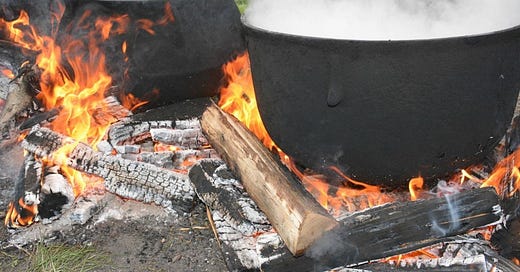SC Lowcountry Fall Traditions Part Two: Down-home, old-time hog butchering
Rural families keep old Southern traditions alive in an uncertain modern world.
Highlights: Preserving an old Southern farm tradition; controlling wild hogs in a tasty, economical manner; recipes for authentic liver-and-rice pudding, Cajun-inspired Lowcountry Boudin sausage and the best Mexican-style Chorizo north of the Rio Grande.
Author’s Note: Recent events, from the pandemic and natural disasters to political and economic turmoil and even the threat of global warfare have served as a reminder to many of us that life can be uncertain and the means to survival isn’t always a grocery store away. The old ways were good ways, and perhaps we shouldn’t let them die.
Pigs on the ground. In the old days, the annual fall killing would begin well before dawn. A prayer to thank the Good Lord for the lives offered to feed our families, and then every man was responsible for dropping his own pigs painlessly and cleanly. That was our way.
Men and soon-to-be men gathered around a fiery wood stove, steam rising from coffee and breath in the frigid Southern morning air. Breakfast was grits, fried pork or last year’s sausage, eggs from a chicken that slept just a few feet away, finished off with hoe cakes and our own farm-made cane syrup.
The first hint of daylight would find pigs hanging from gambrels under ancient oaks that could bear witness to generations of farming traditions like this. Course, wiry hair was steamed and scraped off in huge vats that doubled as sugar cane syrup boilers. Meat hanging, the head and choice organs were removed and set aside for cleaning and cooking. Almost every part of the pig was used, down to the “chitlin’s,” which the older women would clean out with a stick and a bucket of water.
“The old folks always joked that they used every part of the pig except for the squeal,” said Perry McAlhaney, who still lives on this century-old family farm his grandparents built. “Those old people came up in The Depression, when there wasn’t anything to be had and no one had much cash money to speak of. What they had, they had to grow it or shoot it, and you didn’t throw anything away.”
The last man to arrive always caught hell and jokes. “Here comes ‘Old Blister!’ Shows up when the work is done!” The young are put to work chopping firewood and wrestling carcasses to the cutting table, the veterans put their knives to work separating meat from bone, and the older men — or the lazy men, depending on who you ask — volunteer to build the fire and tend to the boiling pots. This isn’t Paula Deen cookware — these are large cast iron pots that are 90-something years old and counting. Want to talk about priceless? Those same deep-black, smoke-smudged pots have cooked liver pudding, washed clothes and even bathed “young’uns” for three generations of Southerners. You can’t find a pot like that in Wal-Mart.
(Consider supporting a Southern writer with a subscription, and perhaps a gift subscription for a friend or family member!)
Making Meat
Forget the local butcher: we cut our own chops and roasts around here, as well as grind, stuff and smoke our sausage and even make our own bacon and lard, but the grand finale is always the liver pudding.
Keep reading with a 7-day free trial
Subscribe to DeWitt's End to keep reading this post and get 7 days of free access to the full post archives.




